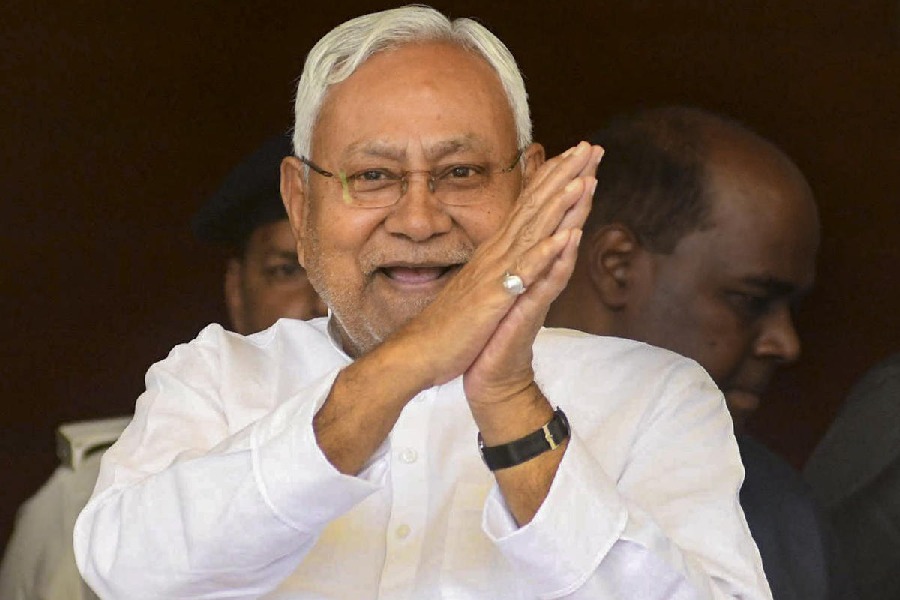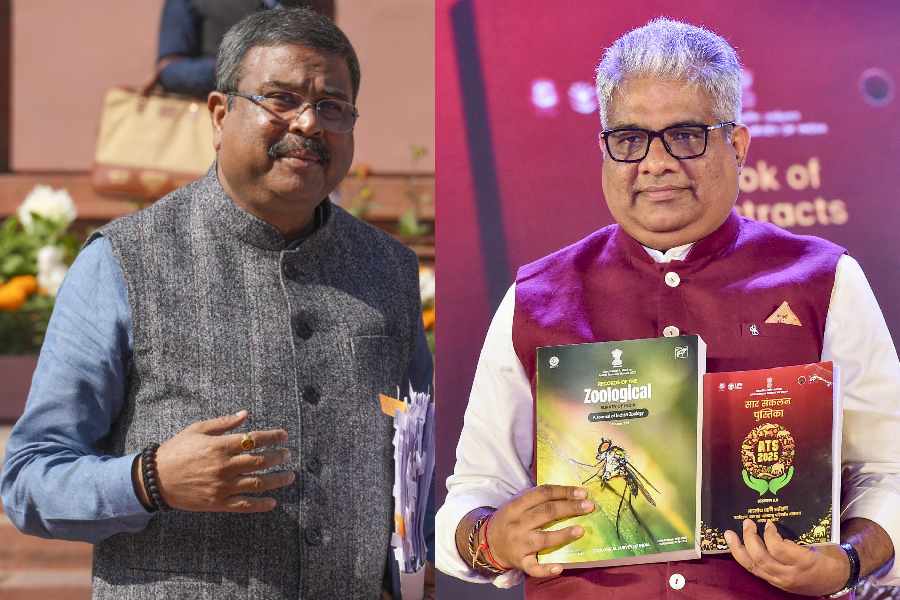To chocolates with Love
 |
What: Chocolate smileys and lollies.
Where: Chocoxpress, 16B Sarat Bose Road (beside Nepal Sweets).
Price: Rs 50 (per piece).
What: Rum-based dark chocolate.
Where: Afraa Deli, City Centre Salt Lake.
Price: Rs 45 (per piece).
What: Chocolate record.
Where: Krazy For Chocolates, Forum (ground floor).
Price: Rs 200.
What: Dark truffles.
Where: Afraa Deli, City Centre Salt Lake.
Price: Rs 40 (per piece).
 |
What: Cashew truffles.
Where: Candy Treats, Forum.
Price: Rs 120 (for 100g).
What: Chocolate bouquet.
Where: Krazy For Chocolates, Forum.
Price: Rs 1,100.
What: Hazelnut truffle chocolate.
Where: Candy Treats, Forum.
Price: Rs 120 (for 100g).
What: Turkish Raisins.
Where: Flurys.
Price: Rs 100 (for 100g).
What: Hazelnut, almond, white chocolate and dark truffles.
Where: Kookie Jar.
Price: Rs 25 (per piece).
What: White and dark chocolate rose.
Where: Flurys.
Price: On request.
 |
What: Sugarfree chocolate.
Where: Flurys.
Price: Rs 150
(for 100g).
What: Vodka chocolate.
Where: Chocoxpress, 16B Sarat Bose Road (beside Nepal Sweets).
Price: Rs 35 (per piece).
What: Chocolate SMS.
Where: Krazy For Chocolates, Forum.
Price: Rs 125.
Priscilla Corner on chocolate treatments that keep you looking good enough to eat!
 |
Body wash
From the relaxing aroma to the skin-softening properties that the cocoa butter ingredient lends, chocolate body washes make bathing a rejuvenating ritual.
Lip gloss
This flavourful cosmetic could be a precarious one for the chocoholic. The temptation to lick it off may be too hard to resist. Its inviting aroma coupled with its chocolate content will leave your lips softer and eminently more kissable.
Moisturiser
The cocoa butter in most chocolate creams moisturises and rejuvenates more than your average emollient because of its high anti-ageing antioxidant content. It softens dead skin cells making them easier to slough off during exfoliation. Treat yourself by lathering up in oodles of it whenever possible.
Chocolate waxing
Rumour has it that Victoria Beckham keeps the oomph factor in her love life on an overdrive with regular chocolate waxing sessions. Chocolate has anti-inflammatory properties that take away the redness and pain normally associated with waxing and is especially desirable for those wanting their bikini lines done. The skin feels silky smooth and the hair takes longer to grow back too. [Which may not be a good thing since visits to the salon for any chocolate treatment can leave you feeling so primed you want to go back as soon as possible!]
Chocolate body spa
By far the biggest hit is the chocolate body spa. Here, the body is polished with a special chocolate sugar scrub after which it is wiped clean with a towel using a rose water and chocolate essence brew. Then, surrounded by the intoxicating aroma of chocolate, the body is smeared with a thick rich chocolate mask. The rich moisturising effect of the mask is heightened by the sealing in of its rejuvenating ingredients when the body is wrapped in cellophane. Fifteen minutes later, the cellophane wrap is removed, the mask is washed off and a light chocolate moisturiser is applied. If this doesn’t leave you feeling like a mouth-watering chocolate diva worth melting for, nothing will!
Choose your chocolate with care for a healthy heart, says Hena Nafis
 |
Chocolate — the food of gods — leaves its competitors far behind in the league of comfort foods. However, it often leaves us with a feeling of guilt and vulnerability to temptation. But does everything that tastes good have to be bad for health? Let’s check out if chocolate has any goodness at all.
Chocolate is made by fermenting, roasting and grinding the beans of the cacao or cocoa tree. The cocoa bean is bitter in taste and gives chocolate its unique flavour, but it is the cocoa wherein lies the health benefits. The cocoa seeds contain flavonoids, which are powerful antioxidants that help the arteries stay flexible. It works like aspirin in preventing blood clots, thereby protecting us against both heart attacks and strokes. Regular consumption of cocoa products can also help lower blood pressure.
Chocolate not only contains heart-healthy flavonoids, but also mood-enhancing phytochemicals, which make it beneficial for both the body and mind. Apart from its irresistible flavour, it contains serotonin, which acts as an antidepressant. It stimulates endorphin production — a feel-good neurotransmitter. Not only does it banish your blues, it makes you feel happy too.
Some studies have shown that chocolate may also have anti-cancer benefits by reducing cell damage that can spur tumour growth. There have been claims that chocolate improves learning and can help with math. However, more studies are required to confirm the link.
But before you pick up your flavonoid-rich treat, remember that not all chocolates are equal in their polyphenol content. The forms in which chocolate is commonly consumed are highly processed and processing lowers the flavonoid content. The darker the chocolate, the higher are its cocoa and flavonoid levels and the greater its health-enhancing quality.
COCOA POWDER: 75 per cent cocoa solids. It is low in calories and full of flavonoids.
DARK CHOCOLATE: 43 per cent cocoa solids. Studies have shown that dark chocolate has eight times the polyphenol antioxidants found in strawberries. Dark chocolate is also known as “bitter-sweet” or “semi-sweet” chocolate. It contains a high percentage (up to 75) of cocoa solids, and little (or no) added sugar.
MILK CHOCOLATE: 30 per cent cocoa solids. This kind of chocolate has lower levels of flavonoids. Milk chocolate, to be “legal”, must contain 10 per cent (US) cocoa solids and 25 per cent (European).
CANDY BAR: 15 per cent cocoa solids.
WHITE CHOCOLATE: It contains no flavonoid at all. It is nothing but a mix of cocoa fat, sugar and flavouring. Ivory in colour, it gets its chocolate flavour from cocoa butter.
The amalgamation of dark chocolate and cocoa powder in a diet that is rich in other food sources of antioxidants, such as fruits, vegetables and tea, results in a high antioxidant intake and may consequently reduce the risk of cardiovascular disease. Chocolate, however, should not replace fruits and vegetables. One must also bear in mind that it is high in calories, hence not good in high quantities. You should limit yourself to an ounce per day.
No doubt dark chocolate is ranked favourably as a health food. Why, then, has chocolate acquired such an unhealthy reputation? It’s because of the ingredients we add to it. Nearly all of the calories in a typical chocolate bar are sugar and fat. To derive health from your favourite snack, choose darker varieties with low sugar content.
Saionee chakraborty’s sweet dream comes true as she rolls her first batch of truffles at the kookie jar chocolate factory
I share a deep bond with chocolate. It is my faithful 3am friend. The moment I sink my teeth into a bar — and here, size does not matter — I forget about everything else. I hate sharing my chocolate. I will measure and weigh only when I am forced to, and it is always likely that the bigger piece will be the one making the journey to my mouth.
I sometimes think I can devour an endless number of chocolate bars, endlessly. I have allegedly been guilty of this lack of discretion since before I could talk, a habit which, according to my mother, has not always been the kindest to my teeth. But I ate on unhindered, only pausing to nurse the fond dream that one day my father would take up employment at a chocolate factory.
Alas, since that wish was never fulfilled, I moved onto the idea that I could play my own fairy godmother and get a job that had something to do with chocolate (eating it, of course) or find a man to marry who has access to chocolate 24x7.
But neither of these fantasies has come true, either. Yet.
And then it hit me: why not temporarily satiate my unquenchable appetite with a trip to a chocolate factory? Better me than Charlie, I say. And instead of travelling to the hallowed shores of Belgium or Switzerland, there is a place to be found at a far easier distance: the Kookie Jar factory right here at home.
First date
 |
My tryst with chocolate destiny was to be kept at the Kasba Industrial Estate. There greeting me on the second floor was a smiling Niranjan Murthy, chef, culinary research.
My olfactory system seemed to be working overtime from the minute I stepped inside the large, chilly room. All my senses were on high alert and the smell alone was enough to make me swoon. The source of the intoxicating aroma? Silken, beautiful brown rivers of chocolate being melted in a corner. (How I wanted to take a dip in that vat!) My joy-filled eyes moved on to truffles being rolled. And then to slabs of cake receiving a generous layer of chocolate frosting.... I was eating with my eyes.
Kookie Jar proprietor Lovey’s greeting broke the sumptuous spell. “So, are you ready to get your hands dirty?” she asked as she supervised a one-of-a-kind dessert platter for a party at designer Kiran Uttam Ghosh’s house. The chocolate roses by any other name would have smelled as sweet. I had to apply every ounce of self-control I possessed to forget the visions I had conjured of those petals melting in my mouth in order to concentrate on what my hostess was saying.
By any chance had Lovey used the word ‘dirty’ in connection with this magic elixir? She must be joking because no one, not even Ms Kookie Jar herself, had my permission to call chocolate names.
And yet shockingly, she seemed unconcerned by my outrage. “You are soon going to smell of chocolate all over and by the time you leave, I guarantee you will not even like it anymore,” Lovey warned.
I looked at her with one sceptical eyebrow raised. Not likely, I thought. In fact, never would I betray my first love, I pledged in that moment!
But it was time to abandon my plan of a crusade to protect the honour of chocolate and concentrate on the glorious matter at hand: Niranjan was trying to teach me how to make hand-rolled truffles. I simply could not wait to get started.
Still, wait I must. “First, you will have to wear a cap,” he smiled, handing me a transparent elastic strip that opened up into a use-and-throw lid resembling a shower cap. Not exactly haute couture, but since I generally prefer my chocolate without a hair filling, I slipped it on.
And then, from that moment, I only had eyes for the 2.5kg slab of dark cooking chocolate rising like a mirage on the table before me. “Could I just have a bite?” I wanted to ask. Just to prove to myself it is real?
“See how brown and shiny it looks? First you must make sure your chocolate is of the right texture,” said Niranjan. I nodded my head without taking my eyes off the goods.
“If it had turned rat grey, it would mean the chocolate had developed bloom. You can fix it by a process of tempering.” Niranjan went on, oblivious to my agony. “Now let’s chop the chocolate to melt it.”
“And taste while we chop?” I wondered.
I did get a taste — though only of how testing it can be. While Niranjan made the chopping look effortless, the chocolate resisted my knife with a vengeance. But it wouldn’t do any good to whack the thing into oblivion; it had to be chopped into even pieces. “Don’t saw it, use the heft to chop,” he explained. Finally Niranjan held my hand and helped me conquer the cacao, following which I contributed a few chunks to the melting pot.
In my world, Juliette Binoche’s Vianne stirring pots of resplendent chocolate in Chocolat is one of the yummiest celluloid scenes ever. And finally, my Vianne moment had arrived. But not without some helpful tips first.
“Never put chocolate directly on heat. It will burn,” advised Niranjan. “Ensure that the bowl for the chocolate is absolutely dry. Then place the chocolate-filled bowl over a pan of hot water. Or, use the microwave.”
We were well on our way to making the truffles. And yet not a drop of chocolate had been tasted! I was running out of patience. “How can you control yourself when you are surrounded by chocolate all day?” I asked Lovey and Niranjan suggestively. They just smiled. “One part heavy cream and dark chocolate will give you truffles,” explained an immune Niranjan.
Rolling a truffle, I discovered, is a lot like shaping a nadu, Bengali sweets made from coconut and jaggery. While you dab your hands with mustard oil before rolling nadus, the trick to making a perfect truffle is to dust some cocoa powder onto your palms. And then you have to roll real fast. “The less time it stays in your hands the better because the heat generated will spoil the taste,” said Niranjan.
My very first batch of truffles were rolled and topped with crushed, toasted almonds, nougat and chocolate flakes. And then it was time for them to meet their drooling maker (me, of course). The fruit of my labour tasted like manna. But then again, when it is chocolate, how can you possibly go wrong?
Lovey pens the recipe of an exotic treat from Kookie Jar
 |
Dried figs coated with white and dark chocolate
Ingredients to make dark ganache
Cream 70ml
Dark chocolate (chopped) 125g (72 per cent cocoa)
Cointreau 10ml
Finely-grated orange zest 1½ tsp
Plump dried figs 500g (30)
For coating
Dark chocolate (chopped) 150g (72 per cent cocoa)
White chocolate (chopped) 150g (72 per cent cocoa)
Method
To make ganache
1) Pour cream into a small pot and place over medium heat. Heat to just below boiling point. Remove from heat and add chocolate.
2) Stir till the chocolate melts and amalgamates with the cream. You may need to return the pot to the heat for a short time if the chocolate does not fully melt. Add Cointreau and orange zest and stir well to combine.
3) Pour into a shallow tray, leave aside to cool.
4) In a slightly cool room, roll ganache into 30 5g-6g balls.
5) Place the balls on a tray and refrigerate for 15 to 30 minutes or until firm.
6) Mould each fig with your fingers to enhance the fig-shape.
7) To make a pocket for the ganache balls, cut the base of each fig and extend the cut one-third of the way up the sides of the fig.
8) Place one ganache ball into centre of each fig and reshape the fig.
For coating
1) Line a tray with aluminum foil. Place the second measure of chocolate in a bowl and place the bowl over a pot containing a small amount of water. Place the pot over a low heat and stir the chocolate occasionally till it is about half-melted. Remove the bowl from heat and stir until all the chocolate melts.
2) Dip a stalk of fig into the melted chocolate to three-quarters of the way up the sides. Gently shake to remove excess chocolate.
3) Transfer to prepared tray and cool till chocolate is set.
4) It can be stored in an airtight container in the refrigerator for up to one week.
Swissotel Japan’s Darren Harding shares an easy bake
 |
ChocolateSpice Cake
Ingredients
Butter 480g
Sugar 480g
Egg yolk: 36
Egg white: 36
Sugar: 120g
Almond powder: 1.2kg
Cocoa powder 225g
Baking powder 12g
Chopped chocolate 600g
Salt 5g
Vanilla oil 5ml
Ground cloves 5g
Cinnamon 20g
Ginger 10g
Brandy 150ml
Method
Boil butter and sugar into a cream paste. Make a meringue from egg white and sugar. Sift the rest of the ingredients and add the cream paste. Bake it at a temperature of 160°C-180°C. Makes 4-5kg.
Shaun Kenworthy hopes that someday the best chocolates will not be imported but be available closer home
The wonderful runny and melty world of chocolate has to be an ingredient to be reckoned with but only the good stuff, of course. So much so that the world is fast running out of the stuff. The consumption over the past 10 years in the “new world” has been so much that over the next 10 years, producers will have a difficult time trying to keep up with the insatiable desire for the stuff and if we are not careful, while every news channel is talking about oil prices hitting global highs, the same will be said for the cocoa bean and coffee bean. And yes, I suppose at the end of the day, practically anything edible!
 |
I’ve spent most of my life fiddling around with chocolate in some way or form and indeed, it has to be the most wonderful thing to stuff into your gob! And even after all of that fiddling, I’m much more a fan of chocolate in its unadulterated state. Adding anything to it just dilutes the taste and sumptuousness. I’ll hold my hands up to a good gooey chocolate pudding, squidgy choco cookie or chewy brownie but otherwise, it’s all dilution for dilution sake.
Just a couple of months ago, I went to a tasting of single origin chocolate, unfortunately as with most imported chocolates in India, the chocolate had been heated, cooled, reheated and cooled so much along its journey, maybe sitting in the port for days waiting for clearance that the chocolate had bloomed. You know what I mean by chocolate bloom — if you buy chocolate in India, you see it most of the time, especially in the summer. The outside of the chocolate has a white fatty film and it affects the flavour, intensity, has no texture, becomes brittle, has no fragrance and feels horrible in your mouth. Ever noticed how shopkeepers switch off the refrigerator or the air-con to save on electricity? That causes a different kind of bloom, too.
But the good news is that we have already started to see better quality chocolate in India and hopefully will see the best. The only problem is that India still has a poor infrastructure and supply chain to ensure that something as temperature-sensitive as chocolate reaches the consumer in its peak condition. That’s also why most manufacturers in India and other tropical countries take the easy route and make chocolates with what’s known as compound chocolate. It’s cheap, has no cocoa butter, only vegetable fat, melts at a high temperature so doesn’t go all melty and tastes like crap. Really! Even the chocolate big boys like Cadbury etc. that manufacture in India — the flavours are different from what they make in the West. For milk chocolate lovers, Cadbury Dairy Milk Silk has made a good attempt but we’ll see if it lasts. For the regular user, Bournville is the best chocolate to buy to use in recipes but if you can get it, I still think that the south Indian manufactured Morde (pure chocolate, not to be mistaken with their compound) is one of the best in Asia.
All in all, if you love and worship chocolate as much as I do, you’re still better eating chocolate out of India — although during the winter months, chocolate is usually much better but I’m sure we’ll get to a stage soon when chocolate in India is great all the year round.
To see if the chocolate is pure or compound, pop a piece in your mouth. If it melts after a little while, then it’s surely chocolate. If it doesn’t and it forms a film on the inside of your mouth, then it’s definitely compound and don’t go back there to buy it ever again and tell your friends too! Education has to play a part in us eating the best quality chocolate someday. Fingers crossed!










